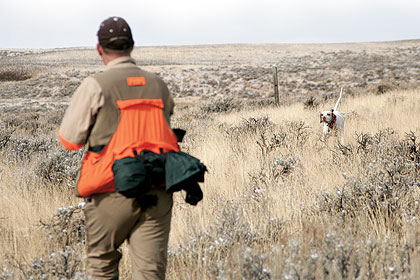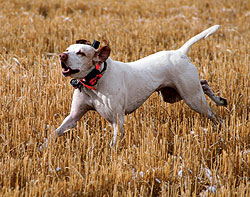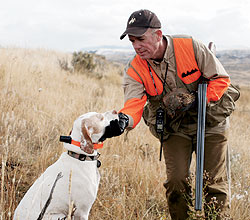English pointers may not be for everyone, but they're just about the hardest hunting bird dogs going.
By Dave Carty
And it is exactly this kind of ground-eating side excursions that many bird hunters have come to expect from pointers. Say "English pointer" in apres-hunt bull sessions and half the room will be singing the breed's praises while the other half heads for the bar. Some will swap you word for word with horror stories of their own.
 "Jimmy! JIMMMYYY! JIIMMMYYY!" That's my friend Bill serenading his English pointer, Jimmy, who has just run out of earshot. This would not be Jimmy's first hunt on the lam. Jimmy--whose middle name might as well be damnit!, as in, "Jimmy, damnit! Get back here!"--is prospecting familiar terrain, which includes most of the land base in neighboring counties. |
There's some truth to the bad press. I remember my one and only trip to the National Pointing Dog Championships several years ago for a lot of things: the camaraderie, the great dogs, the stately Ames plantation and the endless, relentless rain. But one day, following the gallery in the orange pumpkin, a rusting Suburban that several of us without horses were consigned to, I spied a rider trotting his mount directly toward us. He splashed up alongside our truck, reined up his horse and tipped back his hat. Rain dripped off the brim.
"You boys seen that lil' ol' white dawg of mine?" he said.
I don't know if he ever did find his dog. He slogged on down the road and we never saw him again.
But I also remember Jimmy's first point. Bill and I were hunting a wheat field above my hometown, since converted into an "estate" and trophy home for a vacationing Floridian. I'd brought Bill here because there was always a covey or two of Huns tucked into the grassy draws beside the wheat stubble, and at six months of age, Jimmy was ready for action.
That isn't something you can say about every breed. My last setter--and God knows, I'm a setter lover to the bone--was just starting to give me solid points on planted pigeons at six or seven months of age, forget about wild birds. But English pointers are known for being quick studies, and Jimmy was no exception. As Bill and I walked up a long, gradual incline, I spied the very tip of his pure white tail standing straight and proud above the wheat stubble. We walked in, and the covey flushed into a grand, western sunset. I can't remember what happened then, whether we killed birds on the rise or not.
Jimmy's point was the important thing, and that point I remember still.
And another thing: that pointer that was lost at the Nationals? There were dozens of others that didn't get lost, that returned to their owner's side at the end of the three-hour brace. That's a pretty good rate of return for dogs bred to hunt several hundred yards before a fast-moving horse.
Although there are good dogs in virtually every breed, because of their inherently larger gene pools, by and large I'm a believer in sticking with well-established breeds, and there is probably no more established bird dog in this country, setters excepted, than the English pointer.
Much of the credit for that development should go to the late Bob Wehle, who devoted his life to improving the breed. Wehle was born into the family that owned the Genesee Brewing Company in upstate New York, and evidently never really had to work at a nine to five job. But he was anything but a ne'er-do-well.
He was fascinated by genetics throughout his long life, and at various times he bred thoroughbreds, champion dairy cows (some of his stock set milk production records that still stand) and swine. But bird dogs and English pointers were his most enduring love. He called his line of dogs Elhew pointers ("Wehle" spelled backwards), and to this day there are those who think they set the standard for biddable, foot-hunting English pointers.
 Like most pointers, Jimmy loves to run... |
Mark Wendling is among dozens of breeders who carry the Elhew torch. Wendling has been a bird hunter and field trialer for most of his life, and for the last 46 years has been raising bird dogs of several different breeds. He's been interested in pointers for decades, but seven years ago some Elhew dogs caught his eye. I spoke with him because he hunts extensively in the grouse woods near his kennel in Bayfield, Wisconsin (www.superiorpointers.com), as well as on the prairies of South Dakota. He would, I reckoned, have a good feel for how the dogs ranged and handled in vastly different types of cover.
And, I suppose, I wanted him to disprove the myths. Were English pointers really as hard-headed and tough to control as I'd heard? His frank answers surprised me.
"The qualities that make a competitive horseback field trial dog are not necessarily the same qualities that make a dog a good upland shooting companion," he told me. We were having a rambling, hour-long conversation over the phone. "The emphasis on extreme range and independence has continued to produce an ever more exciting field trial dog, but at the same time has probably widened the gap between those dogs and what the typical bird hunter wants. Pointers," Wendling said, "do tend to be aloof, and I would have to say that a lot of them really don't seem to like people." So there it was, out in the open.
But Elhew pointers, he also told me, were almost like a different breed. "They're different enough," he said, "that a lot of people think they ought to be a separate registry."
Wendling claims that on the prairies his dogs stretch out and deliver the mail, but stay within comfortable foot-hunting distance in the grouse woods, often just 40 to 50 yards.
"And they do it without a lot of hacking or a lot of handling," he said. "I probably would be raising a different breed if I didn't have the Elhew pointers."
My experience with pointers is limited to the half dozen dogs I've hunted over in the last couple of decades, all of whom had legs and knew how to use them. Bill's dog Jimmy--Bill doesn't know if it's an Elhew dog, nor does he particularly care--is a hodgepodge of conflicting characteristics. He's a big runner, and his relaxed, rocking-horse gait is deceptive: take your eyes off him for a moment and he'll canter over the hill and disappear.
But there are also days when he handles like a dream, checks
back in on a regular basis, and in every respect behaves like the gentlemen we both know he really wants to be, if only he could tame the inner demons that relentlessly drive him to find birds a mile or two beyond the boundaries of wherever it is we have permission to hunt.
Training would settle him down considerably, but Bill's photography business keeps him constantly on the move, and Jimmy has never really got the hands-on discipline he sorely needs, something Bill is the first to admit. As a consequence, we've both learned to keep our eyes on him.
Sooner or later he comes back, but sometimes the dog really worries me. The worst incident was probably a few years ago, during what would develop into a blinding snowstorm.
We'd arrived at the ranch with clouds scudding low across the backside of the Bridger Mountains and a cold, biting wind that promised bad weather before dark. We zipped up our vests, shouldered our guns and dropped the tailgate of my truck. Jimmy shot out, and after Bill grabbed him and wrestled him into his e-collar, we set off across the prairie, flakes of snow stinging our cheeks like wind-driven sand.
 ...but he can also deliver the goods. |
At first, the Jimster was all manners and style. He's a great dog to watch, graceful and athletic, and has a nose that can find birds other dogs, including mine, sometimes miss.
We worked our way around the north end of a wheat field, where we dropped into a draw and gained, for a few brief minutes, a merciful respite from the wind. Then we climbed out and into the open, working our way up a ridgeline where I'd found birds before.
Any normal gamebird would have been hunkered down in the draw, but Huns live in relentless gales year around and seem to pay them little attention. As we clambered ever closer to the ridgeline, the wind began to screech and the snow began in earnest, blowing sideways into the gaps between our buttoned up collars and stinging our ears. It was then, when Bill and I both had to shout to hear one another, that Jimmy, who is almost pure white, vanished into the teeth of the storm.
One minute we were talking and watching the dog and the next he simply wasn't there.
Bill stared blankly into the swirling white and then stuck his whistle between his teeth.
But a series of shrill blasts, one after another, produced nothing. I was trying not to worry. Pointers are thin-haired dogs and it occurred to me that Jimmy could easily freeze to death if we didn't find him before dark, which was an hour and a half away at best. We decided to split up and look for him.
I struck off up the ridge, blowing my whistle, and Bill backtracked down, hoping Jimmy had circled downwind to catch our scent. I wasn't so sure. Jimmy has such intense drive to hunt that it's unlikely he ever realized he was lost. Yet a half hour later, he still hadn't returned.
Occasionally, during lulls in the shrieking gale, I'd hear the faint, shrill blast of Bill's whistle, a forlorn, futile trilling that served only to heighten the desperation I was beginning to feel. I spent another fifteen minutes trudging along the ridgeline, my head down and shielded from the stinging snow, stopping every dozen yards or so to blow my whistle, then finally gave in to the hopeless futility of it all and began trudging back downhill.
Suddenly I heard the thump of paws, and as I spun around I saw Jimmy racing by me on his way to Bill, who now was standing a hundred yards below. I dove for his neck as he romped past and immediately cinched a lead to his collar. Jimmy was panting, but pleased as could be. Hard to say what he'd been doing out there.
"No more for him," I told Bill. "He's done. Let's get the hell out of here." Bill, whose vast relief I can only guess at, nodded in mute agreement. It's hard to believe that this bird-crazed animal is the same creature that shares Bill's house every day of his life and as often as not, his warm bed. Jimmy is the goofiest clown
I've ever been around. He'll scuttle under his favorite blanket, then proudly parade around the house wearing his regal "cape." If someone won't do it for him, he'll stand at the top of the stairs and toss one of his favorite squeaky toys down them, then yelp with glee and free-fall downstairs after it.
He just knows you want to pet him, so why pretend otherwise? Jimmy is all shivers and happy anticipation, and bounds off the front porch to meet each and every guest that arrives. He's getting on in years now, but he's a puppy at heart, and I can't imagine him ever being any other way.
English pointers, Mark Wendling says, are not for beginners. Jimmy is proof of that. But my next dog? I'm not a beginner, and since I've always admired pure, unadulterated talent, I'm leaning toward getting a pointer myself.
Stay tuned.






